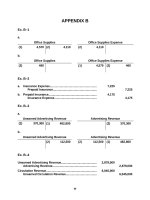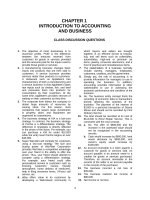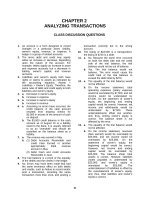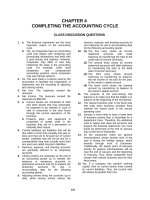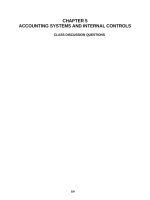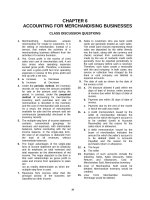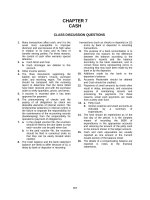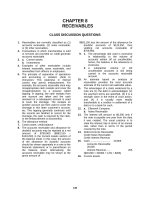Solution manual investments 10th by jones ch03
Bạn đang xem bản rút gọn của tài liệu. Xem và tải ngay bản đầy đủ của tài liệu tại đây (58.9 KB, 12 trang )
Chapter 3:
Indirect Investing
CHAPTER OVERVIEW
Chapter 3, covering indirect investing, is a logical
sequence to Chapter 2, which focused on direct purchases and
sales of assets by investors. Furthermore, investment companies
warrant a separate chapter. The importance of investment
companies, primarily mutual funds, to investors in the 1990s is
obvious, and it continues to increase in the 21st Century. For
most investors, investment companies in some form are an integral
part of their investing activities. This material deserves
emphasis as a separate chapter where the relevant issues can be
read and studied as a unified package.
It is also important that investment companies be studied
early on in an investments course because of the many references
to mutual fund investing that are likely to occur. Students
should be exposed to this material early, and make use of it
during the course. It may often be the case that term papers or
term projects will involve mutual funds and/or other investment
companies.
Chapter 3 begins by showing how households have increasingly
turned to indirect investing through pension funds and mutual
funds. Some discussion of financial intermediation may be
appropriate at this point. The dramatic growth in mutual fund
assets is illustrated with a graph.
The process of investing indirectly through investment
companies is explained and illustrated with a graph. The
increasing movement toward “fund superstores” at brokerage
houses, thereby combining direct investing with indirect
investing, is mentioned.
The basic concept of an investment company is discussed in
terms of how it is organized, regulated, and operated. This is
followed by a discussion of the three types of investment
companies: unit investment trusts, closed-end funds, and open-end
funds. Included here is a discussion and illustration of net
asset value.
25
Mutual funds receive primary emphasis in Chapter 3 because
that is the type of investment company most frequently owned.
Money market funds are discussed first, followed by equity and
bond & income funds. The types of mutual funds are considered,
using the objectives defined by the Investment Company Institute.
Value funds and growth funds are considered, and the dramatic
growth of all mutual funds is discussed.
The details of indirect investing are considered next. What
is involved when buying a mutual fund or closed-end fund in terms
of how to do it, the expenses involved, and so forth?
Investment company performance is analyzed in Chapter 3,
although a detailed discussion of return and risk measures does
not occur until Chapter 6. Performance is explained using actual
data for one fund. The consistency of mutual fund performance is
explored.
The Eighth Edition contains a discussion of exchange-traded
funds because of their emerging importance. Some detail is
provided on the differences between ETFs and mutual funds, as
well as closed-end funds.
Investing internationally through investment companies is
analyzed because many investors are interested in international
diversification.
CHAPTER OBJECTIVES
To emphasize the important alternative for all investors of
indirect investing, and how it fits in most investors'
overall plans when investing.
To explain the various types of investment companies,
including how they operate, objectives, expenses, and so
forth.
To discuss important issues such as fund performance and how
to use funds to invest internationally.
To discuss important new developments in this area,
primarily exchange-traded funds.
26
MAJOR CHAPTER HEADINGS [Contents]
[Introduction explains increasing importance of indirect
investing to households--the rising ownership of pension
fund assets and mutual fund shares]
Investing Indirectly
[diagram showing direct and indirect investing; rise of
indirect purchase of investment companies in brokerage
accounts]
What Is An Investment Company?
[how organized, regulated, and operated]
Types of Investment Companies
Unit Investment Trusts
[definition, characteristics]
Closed-End Investment Companies
[characteristics]
Open-End Investment Companies (Mutual Funds)
[how organized and operated; net asset value description and
calculation; examples using a Fidelity fund; minimum
investment requirements]
Major Types of Mutual Funds
Money Market Funds
[description; characteristics; holdings]
Equity and Bond and Income Funds
[description; objectives of these funds; growth funds and
value funds; growth of these funds]
The Growth in Mutual Funds
[growth in number of funds; changing distribution of assets
by type of fund]
27
The Mechanics of Investing Indirectly
Closed-End Funds
[discounts and premiums]
Mutual Funds
[load funds, no-load funds, and low-load funds; fees, such
as 12b-1; management fee]
Investment Company Performance
[total return; cumulative total return; average annual
return--explanation and examples]
Benchmarks
[different funds use different benchmarks]
How Important Are Expenses?
[expenses are increasing and investors should be aware]
Consistency of Performance
[the controversy continues]
Investing Internationally Through Investment Companies
[international funds; global funds; single-country funds]
New Developments in International Investing
[passively managed country funds, WEBS and CountryBaskets]
Exchange-Traded Funds (ETFs)
[mechanics; types; how they work]
Distinguishing Among ETFs, Closed-End Funds, and Mutual
Funds
The Future of Indirect Investing
[fund supermarkets offered by brokerage houses]
28
Appendix 3-A
Obtaining Information on Investment Companies
Daily and Weekly Price and Performance Information
Obtaining Information About Investment Companies
POINTS TO NOTE ABOUT CHAPTER 3
Tables and Figures
There are no tables in Chapter 3.
Figure 3-1 shows assets of mutual funds for selected years.
The dramatic growth in assets is obvious.
Figure 3-2 illustrates the difference between direct
investing and indirect investing. The important point here is
that indirect investing accomplishes the same things as direct
investing.
Figure 3-3 shows basic information for a few closed-end
funds. Illustrated are net asset value and market price, and the
discounts and premiums that result.
Figure 3-4 shows the minimum investment requirements for
mutual funds. These are, all in all, quite low and illustrate
that most investors can invest by using mutual funds.
Figure 3-5 shows the major investment objectives of mutual
funds. This allows us to organize mutual funds by objective.
Figure 3-6 shows a “style map” for Fidelity’s Equity-Income
fund. This map shows at a glance the types of securities a fund
invests in—for this fund, large cap, value stocks.
Figure 3-7 shows the assets of stock and bond & income funds
over time. Equity funds constitute about 60 percent of the total
assets in this category, and have enjoyed recent rapid growth.
Box Inserts
29
Box 3-1 discusses fund taxes. This issue has been in the
news quite a lot lately. More and more investors are concerned
about the tax efficiency of inefficiency of their mutual funds
after what happened in 2000 when a number of funds made very
large capital gains distributions even as their NAVs declined
sharply in the market drop.
30
ANSWERS TO END-OF-CHAPTER QUESTIONS
3-1.
Indirect investing involves the purchase and sale of
investment company shares. Since investment
companies hold portfolios of securities, an investor
owning investment company shares indirectly owns a
pro-rata share of a portfolio of securities.
3-2.
An investment company is a financial corporation
organized for the purpose of investing in securities,
based on specific objectives.
3-3.
•
Open-end investment companies (mutual funds)
continually sell and redeem their shares, based on
investor demands. Shareowners deal directly with
the company.
•
Closed-end investment companies have a fixed
capitalization, and their shares trade on
exchanges or over-the-counter.
A money market fund is an investment company formed
to invest in a portfolio of short-term, highly
liquid, low risk money market instruments. Interest
is earned daily, and shares can be sold at anytime.
There are no sales commissions or redemption fees.
Most money market mutual funds hold a substantial
part of their assets in the form of Treasury bills
because of their safety and liquidity. In effect,
these funds are doing for investors what they could
do for themselves if they had enough funds to
purchase Treasury bills and earn the going risk-free
rate of return directly.
Money market funds have appealed to investors seeking
to earn the often-attractive rates being paid on
money market instruments but who could not afford the
large minimum initial investments required.
Liquidity is excellent, and safety has been no
problem although an investor’s funds are uninsured.
Fund expenses are very low. In addition, most money
market funds offer check writing privileges (often
with some minimum amount constraint).
The creation of the money market deposit accounts at
financial institutions has lessened the appeal of
money market funds. MMDAs are insured, and locally
available.
3-4.
A closed-end fund selling at a discount is
technically worth more dead than alive in the sense
that if investors could take over the fund, they
could liquidate the portfolio and enjoy a gain.
Think of a closed-end selling at a 20 percent
discount. If assets could be bought for $0.80 on the
dollar and liquidated at face value, in principle a
nice gain could be realized. Of course, attempts to
take over a fund would likely drive the price up and
reduce some, or all, of the potential gain.
3-5.
A regulated investment company can elect to pay no
federal taxes by “flowing through” distributions of
dividends, interest, and realized capital gains to
shareholders who pay their own marginal tax rates on
these distributions.
3-6.
Benefits of money market funds include:
(a)
(b)
(c)
(d)
(e)
(f)
(g)
current money market rates can be earned
securities with high minimum denominations,
which most investors could not purchase, are
held by these funds on behalf of shareholders
diversification
check-writing privileges--investors continue
to earn interest until the check actually
clears
shares are quickly redeemable by wire
no sales charge or redemption charge
interest is earned and credited daily
A possible disadvantage is that these funds are not
insured.
The money market deposit accounts (MMDAs) offered by
banks and other financial institutions are a close
substitute for a money market fund.
3-7.
The board of directors of an investment company must
specify the objective that the company will pursue in
its investment policy. The company will try to
follow a consistent investment policy, given its
objective.
(a)
common stock funds: aggressive growth, growth,
growth and income, international, and precious
metals
(b)
balanced funds:
(c)
bond and income funds: income funds, bond
funds, municipal bond funds and option/income
funds
(d)
specialized funds: index funds, dual-purpose
funds, and unit investment trusts.
hold both bonds and stocks
3.8.
A unit investment trust is an unmanaged portfolio
handled by an independent trustee, while investment
companies are actively managed. The sponsor
maintains a secondary market for the trust for those
wishing to sell, while investment company shares are
traded, or redeemed, more actively. The assets in
the portfolio of a trust are seldom changed, a
situation completely different from an investment
company which pursues a more active management
strategy.
3.9.
The net asset value (NAV) for any investment company
share is computed daily by calculating the total
market value of the securities in the portfolio,
subtracting any trade payables, and dividing by the
number of investment company fund shares currently
outstanding.
3.10.
A pure intermediary refers to the concept of
achieving the same objective that an investor could
achieve directly in terms of owning a portfolio.
That is, a mutual owns a portfolio of stocks which,
in principle, investors could own directly. The fund
passes on to the investors the same dividends and
capital gains that they could earn themselves through
direct investing (less fund expenses).
3.11.
Investors might prefer a closed-end fund because it
could be bought on an exchange, through a broker,
like any other stock. Thus, it would be added to the
portfolio like any other security, and when it came
time to sell all that would be required would be a
call to the broker. Also, an investor might feel
there is an advantage to buying a closed-end fund at
a discount, because a narrowing of the discount would
lead to a gain for the investor. Finally, a
particular closed-end fund might appeal to an
investor better than the open-end funds that are
available because of the closed-end fund’s particular
focus, managers, expenses, past record, and so forth.
3.12.
So-called international funds tend to concentrate
primarily on international stocks. In one recent year
Fidelity Overseas Fund was roughly one-third invested
in Europe and one-third in the Pacific Basin, whereas
Kemper International had roughly one-sixth of its
assets in each of three areas, the United Kingdom,
Germany, and Japan. On the other hand, global funds
tend to keep a minimum of 25 percent of their assets
in the United States. For example, in one recent year
Templeton World Fund had over 60 percent of its
assets in the United States, and small positions in
Australia and Canada.
3.13.
A cumulative total return measures the actual
performance over a stated period of time, such as the
past 3, 5 or 10 years. Standard practice in the
mutual fund industry is to calculate and present the
average annual return, a hypothetical rate of return
that, if achieved annually, would have produced the
same cumulative total return if performance had been
constant over the entire period. The average annual
return is a geometric mean (discussed in Chapter 6)
and reflects the compound rate of growth at which
money grew over time.
3.14.
A value fund generally seeks to find stocks that are
cheap on the basis of standard fundamental analysis
yardsticks, such as earnings, book value, and
dividend yield.
Growth funds, on the other hand, seek to find
companies that are expected to show rapid future
growth in earnings, even if current earnings are poor
or, possibly, nonexistent.
3-15.
Unit investment trusts are considered to be passive
investments because they are designed to be bought
and held, with capital preservation as a major
objective. They are, by and large, unmanaged
investment companies.
3.16.
Mutual fund shares are typically purchased directly
from the investment company that operates the fund.
The investor contacts the company, obtains a
prospectus and application, and buys and sells shares
by mail and phone. Alternatively, mutual funds can be
purchased indirectly from a sales agent, including
securities firms, banks, life insurance companies,
and financial planners. Mutual funds may be
affiliated with an “underwriter,” which usually has
an exclusive right to distribute shares to investors.
Most underwriters distribute shares through
broker/dealer firms.
3.17.
When the investor is ready to sell the shares of
Equity-Income Fund, he or she would contact Fidelity
by phone or mail and instruct Fidelity to sell the
shares. The company is obligated to do so under
normal circumstances at the NAV prevailing at the
time of sale.
3.18.
Since 1986 Equity funds as a percentage of total fund
assets doubled to about 45 percent. Taxable Money
Market funds declined from about 32 percent of total
fund assets to approximately 22 percent. The
percentage of assets held in Bond and Income funds
also declined. In the mid-1990s, investors were
clearly emphasizing Equity funds.
3-19.
Mutual funds are corporations typically formed by an
investment advisory firm that selects the board of
trustees directors) for the company. The trustees,
in turn, hire a separate management company,
normally the investment advisory firm, to manage the
firm.
3-20.
Mutual funds involve investment risk because they
hold risky financial assets such as stocks and bonds.
However, mutual funds are able to reduce risk,
relative to many investors, by holding a diversified
portfolio of securities. Proper diversification may
require 30 or more stocks, which many individual
investors cannot achieve through direct investing.
3.21.
The “load” refers to the sales charge. A no-load
fund has no sales charge, while a load fund has a
sales charge, which may often be as much as 5-6
percent. A low-load fund has a lower sales charge,
often 2 percent or 3 percent.
3.22.
Passively managed country funds are geared to match
a major stock index of a particular country. Each of
these offerings will typically be almost fully
invested, have little turnover, and offer
significantly reduced expenses to shareholders.
Morgan Stanley has created World Equity Benchmark
Shares (WEBS) which track a pre-designated index (one
of Morgan Stanley’s international capital indices)
for each of 17 countries. These are closed-end
funds, and trade on the Amex.
Deutsche Morgan Grenfell has created CountryBaskets,
designed to replicate the Financial Times/Standard &
Poor’s Actuaries World Indices. These are available
for each of nine countries. Unlike WEBS, which
attempt to match the performance of a particular
index without owning all of the stocks in the index,
CountryBaskets own every stock in the index for that
country.
3-23.
Once an investor buys a particular fund within an
investment company, such as Vanguard or Fidelity, he
or she can easily sell the shares of that fund and
purchase shares of another fund within the same
organization. This can be done by phone or mail.

